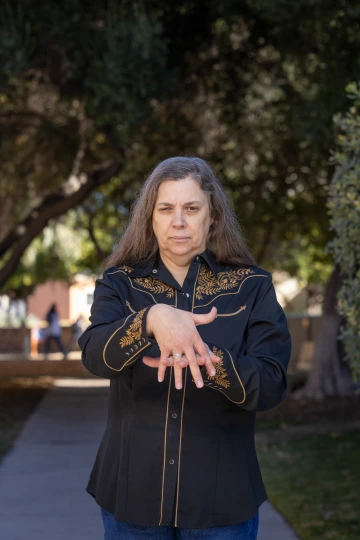The Native Hand Talk Video Dictionary
Native scholar and Cherokee Deaf Melanie McKay-Cody is building a video dictionary for Indigenous sign languages.

Melanie McKay-Cody gives a modernized sign for “Indigenous,” which she helped create in 2012 by blending the Plains Indian Sign Language signs for “Native” and “Native land” with the American Sign Language sign for “root.”
Chris Richards
Melanie McKay-Cody’s passion for language began at just 10 years old when she discovered a book on Native American sign languages at the Oklahoma School for the Deaf. The signs looked different from the American Sign Language she used, sparking a lifelong fascination with her own Native heritage.
Now an assistant professor in the University of Arizona’s College of Education who in early 2025 was named to the 2024 University of Arizona Women of Impact cohort, McKay-Cody is one of the world’s leading experts on North American Indian Sign Language — a vast, ancient network of sign languages she is dedicated to documenting, preserving and revitalizing.
Born in southeastern Oklahoma, McKay-Cody lost her hearing at age 5 due to spinal meningitis. Her family moved to be near the Oklahoma School for the Deaf, where she became fluent in ASL within a month. While her mother and sister picked up some signs, her father and brother used their own gestures to communicate.
“Back in those days, parents didn’t often sign,” McKay-Cody says. “You have to remember, this is the 1960s, when parents weren’t really educated about communication and engagement with their children the same way that we are now.”
McKay-Cody grew up learning about her paternal Cherokee heritage, and in high school she began digging deeper, finding lineage on her mother’s side to nine tribes in the eastern U.S., including the Shawnee Tribe, the Powhatan, the Montauk, the Narragansett and the Pequot.
“I became interested and got involved with older deaf folks who would tell their stories,” she says. “That got me interested in history, and I fell in love with it.”
At Gallaudet University, McKay-Cody studied museum studies, art history and the American West while working in the National Archives as well as Gallaudet’s archives, where she discovered historical records on Native sign languages. She took them home and pored over them, knocking dust off the pages as she read.
After graduating in the late 1980s, she took a research role in Santa Fe, cataloging and cleaning artifacts for an anthropology lab. While analyzing Puebloan petroglyphs, she recognized similarities to Native hand signs from her research, sensing a deeper form of communication. “I knew there was something there,” she says. “I just needed the training to understand it.”
Her training continued at the U of A, where she earned a master’s in sign language studies in 1996. Her research has since helped map the vast network of Indigenous sign languages across North America, collectively known as North American Indian Sign Language, with some referred to as Hand Talk.
Her 1996 dissertation focused on Plains Indian Sign Language, documenting regional differences shaped by environment and culture. She says that sometimes one group will correct her signs, informing her that they belong to another tribe. “So, that’s a moment where I document the differences between the two tribes’ sign languages.”
McKay-Cody later earned a second master’s in linguistic anthropology from the University of Kansas. She also earned a doctoral degree in sociocultural and linguistic anthropology from the University of Oklahoma. (In early 2025, she was named to the 2024 University of Arizona Women of Impact cohort in recognition of her work.)
Decades of research confirmed what she had long suspected — some Puebloan petroglyphs corresponded to Indigenous hand signs. As a Deaf person and Native signer, she could make the connections: A horizontal line across a figure’s torso matched the sign for “hungry,” while a line with a half-circle resembled the sign for “water.”
McKay-Cody has come a long way since discovering that library book at age 10. “Back then, if somebody had told me, ‘You’re going to go on to a Ph.D. and travel the world and do research,’ I never would have believed them,” she says. “That little 10-year-old me could never have imagined where I would be today.”
As one of the few researchers documenting Indigenous sign languages, she is leading the creation of a video dictionary with Native signers, preserving 900 terms across 13 tribal languages. Stored by University Libraries, the dictionary includes English translations, video demonstrations and detailed explanations. She collaborates with 15 tribes to ensure accuracy and cultural integrity.
While some entries may be public, access to others will be restricted to tribal members, safeguarding Indigenous ownership. “The language belongs to Native people,” McKay-Cody says. “Native people are afraid of their language, of their Hand Talk, being polluted by ASL. So, a goal for the dictionary is to make sure that those tribes who have been involved in the research will have access to it.”
